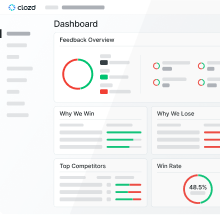
 Product
ProductProducts
Feedback Collection
The Clozd Advantage
Resources
Resource Library
Your hub for insights across the customer journey
Clozd Blog
Access game-changing content from our team of experts
Customer Stories
See how real companies are using customer feedback
Definitive Guide to Win-Loss Analysis
Everything you need to start doing win-loss analysis
ROI Calculator
See how much you can increase your revenue
Watch now

Tailored interviews conducted by certified industry veterans
Check it out
.svg)
Back

Other Use Cases
Feedback Collection
The Clozd advantage









.svg)












.svg)